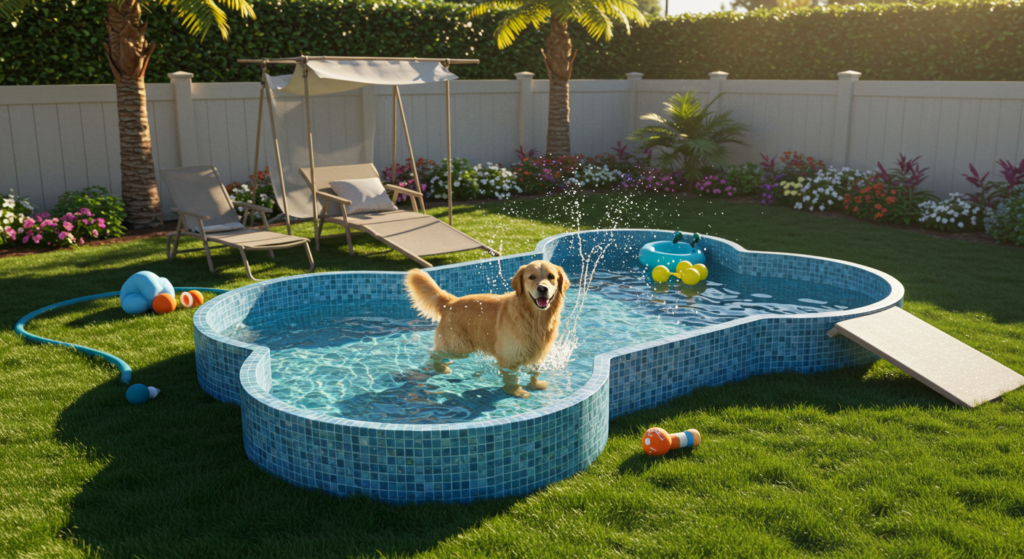Table of Contents
- Introduction: Dive into Canine Aquatic Adventures
- Why a Dog Swimming Pool? Benefits Beyond the Bark
- Choosing the Perfect Pool: Types and Considerations
- 3.1 Inflatable Dog Pools: Easy Set-Up, Easy Fun
- 3.2 Hard Plastic/Foldable Pools: Durable and Portable
- 3.3 Above-Ground Pools for Dogs: A More Permanent Splash Zone
- 3.4 In-Ground Dog Pools: The Ultimate Canine Oasis
- Setting Up Your Dog’s Pool: Location, Safety, and Maintenance
- 4.1 Ideal Location: Sun, Shade, and Drainage
- 4.2 Water Quality: Filtration and Cleaning Tips
- 4.3 Safety First: Non-Slip Surfaces and Supervision
- Training Your Dog to Swim: Making a Splash Positive
- Essential Accessories for Dog Pool Owners
- Beyond the Swim: Fun Pool Games for Pups
- Common Challenges and Troubleshooting
- Conclusion: Making Memories, One Splash at a Time
- FAQs: Your Dog Pool Questions Answered
1. Introduction: Dive into Canine Aquatic Adventures
For many dogs, the allure of water is irresistible. Whether it’s a hot summer day or just a desire for some active fun, a dog swimming pool offers a fantastic outlet for exercise, mental stimulation, and pure joy. Far more than just a large bowl of water, dedicated dog swimming pools are designed with canine safety and enjoyment in mind. This comprehensive guide will navigate you through everything you need to know about providing your furry friend with their own personal aquatic paradise, ensuring endless hours of splishing, splashing, and tail-wagging happiness.

2. Why a Dog Swimming Pool? Benefits Beyond the Bark
Investing in a dog swimming pool offers a multitude of advantages for your beloved pet:
- Excellent Exercise: Swimming is a low-impact, full-body workout that’s gentle on joints, making it ideal for senior dogs, dogs with arthritis, or those needing a safe way to burn off energy.
- Cooling Relief: During scorching summer months, a pool provides a crucial way for dogs to cool down and prevent overheating.
- Mental Stimulation: Engaging with water, retrieving toys, and simply floating can be incredibly stimulating for a dog’s mind, reducing boredom and destructive behaviors.
- Rehabilitation: For dogs recovering from injuries or surgery, hydrotherapy in a controlled pool environment can significantly aid recovery and strengthen muscles.
- Fun and Bonding: A pool creates a fantastic opportunity for interactive play and strengthens the bond between you and your dog.
- Hygiene: Some dogs enjoy a good rinse, and a dedicated pool can be a fun way to help keep them clean, especially after muddy adventures.
3. Choosing the Perfect Pool: Types and Considerations
When selecting a dog swimming pool, consider your dog’s size, your available space, durability, and ease of maintenance.
3.1 Inflatable Dog Pools: Easy Set-Up, Easy Fun
These are popular for their convenience and affordability. Made from durable PVC or similar materials, they are quick to inflate and deflate, making them ideal for occasional use or for smaller spaces. Look for models with reinforced seams and puncture-resistant materials.
3.2 Hard Plastic/Foldable Pools: Durable and Portable
Often made from rigid plastic or durable, non-toxic PVC, these pools are more robust than inflatables. Foldable designs are particularly convenient for storage and transport. They are resistant to punctures from claws and teeth, offering a longer lifespan.
3.3 Above-Ground Pools for Dogs: A More Permanent Splash Zone
For those seeking a larger, more dedicated swimming area, reinforced above-ground pools designed for dogs are an excellent choice. These often feature robust frames and liners built to withstand canine antics. They offer more depth for swimming and can accommodate multiple dogs.
3.4 In-Ground Dog Pools: The Ultimate Canine Oasis
The most luxurious option, in-ground dog swimming pools are custom-built features, similar to human pools but with dog-specific considerations like shallow entry points, non-slip surfaces, and easy-to-clean materials. These are a significant investment but provide the ultimate aquatic experience.
4. Setting Up Your Dog’s Pool: Location, Safety, and Maintenance
Proper setup and ongoing care are crucial for a safe and enjoyable pool experience.
4.1 Ideal Location: Sun, Shade, and Drainage
Choose a flat, level surface away from sharp objects. Consider a spot that offers a balance of sun for warmth and shade for cooling off. Ensure good drainage around the area to prevent muddy messes.
4.2 Water Quality: Filtration and Cleaning Tips
Just like human pools, dog pools require regular cleaning. For smaller pools, frequent water changes are often sufficient. Larger pools may benefit from a small pump and filter system to maintain water quality. Always use pet-safe cleaning solutions and avoid harsh chemicals. Skim out debris regularly.
4.3 Safety First: Non-Slip Surfaces and Supervision
Ensure the pool’s bottom has a non-slip surface to prevent accidental slips and falls. Always supervise your dog, especially when they are new to swimming or if they are breeds not naturally inclined to water. Consider a ramp or steps for easy entry and exit, particularly for smaller or older dogs.
5. Training Your Dog to Swim: Making a Splash Positive
Not all dogs are natural swimmers. Introduce your dog to the pool gradually and positively. Use treats, toys, and gentle encouragement. Never force a dog into the water. Start in shallow areas and gradually increase depth. A dog life vest is highly recommended, especially during initial training and for breeds known for struggling in water (e.g., bulldogs, pugs).
6. Essential Accessories for Dog Pool Owners
To enhance the pool experience, consider these accessories:
- Dog Life Vest: Essential for safety and confidence, especially for new swimmers or certain breeds.
- Floating Dog Toys: Encourage play and retrieval in the water.
- Pool Ramp/Steps: Provides easy and safe entry/exit.
- Dog-Safe Towels: For drying off after a swim.
- Water Hose/Nozzle: For filling and cleaning.
- Pool Cover: To keep the water clean when not in use.
- Pet-Safe Water Treatment: For larger pools to maintain water quality.
7. Beyond the Swim: Fun Pool Games for Pups
Make pool time even more exciting with games:
- Fetch: Toss floating toys for your dog to retrieve.
- “Find the Treat”: Hide waterproof treats in shallow water for them to sniff out.
- Splash Party: Gently splash water to encourage playful interaction (if your dog enjoys it).
- Obstacle Course (shallow water): Set up gentle obstacles for them to navigate.
8. Common Challenges and Troubleshooting
- Punctures: For inflatable pools, keep a repair kit handy. For hard plastic, inspect for cracks.
- Green Water: Indicates algae growth. Increase cleaning frequency and consider a pet-safe algaecide or filter.
- Dog Not Interested: Don’t force it. Try making it more inviting with toys or by getting in with them.
- Too Much Hair in Water: Regular grooming can help. Consider a skimmer net specifically for pet hair.
9. Conclusion: Making Memories, One Splash at a Time
A dog swimming pool is more than just a recreational item; it’s an investment in your dog’s health, happiness, and overall well-being. By choosing the right pool, prioritizing safety, and maintaining it properly, you can provide your canine companion with countless hours of refreshing fun and create cherished memories. So go ahead, let your furry friend experience the joy of their very own aquatic adventure!
10. FAQs: Your Dog Pool Questions Answered
Q1: How deep should a dog swimming pool be? A1: The ideal depth depends on your dog’s size and swimming ability. For small dogs or beginners, 6-12 inches is a good start. Larger or experienced swimmers can enjoy 1-2 feet or more, ensuring they can still touch the bottom if needed.
Q2: Can I use a human pool for my dog? A2: While some dogs use human pools, dedicated dog swimming pools are often more durable against claws, have non-slip surfaces, and are easier to clean and drain. Human pools can also contain chemicals harmful to dogs if ingested.
Q3: How often should I clean my dog’s pool? A3: For small pools, daily water changes are ideal. Larger pools should be cleaned at least once a week, with daily skimming of debris and regular checks of water quality.
Q4: Do all dogs like to swim? A4: No, not all dogs are natural swimmers or enjoy water. Never force a dog into the pool. Introduce them gradually and make it a positive experience with treats and praise.
Q5: What’s the best material for a dog pool? A5: Hard plastic (like thick PVC) or reinforced, heavy-duty vinyl are excellent choices for durability and resistance to punctures from dog claws.
Q6: Is a dog life vest really necessary? A6: Yes, especially for new swimmers, breeds not naturally inclined to water (e.g., bulldogs, pugs), or older dogs. A life vest provides buoyancy and helps build confidence and safety.
